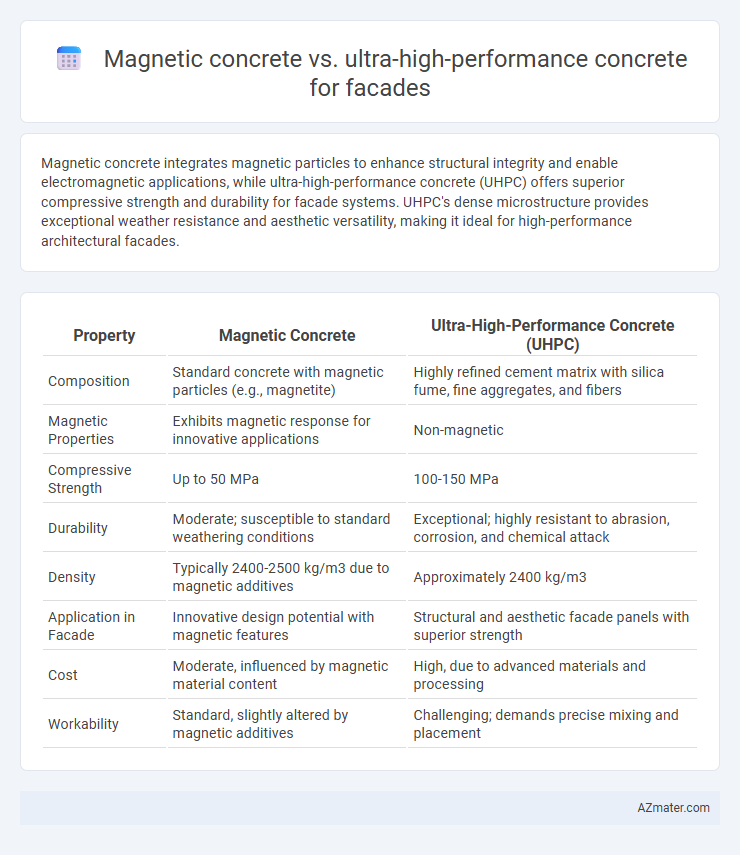Magnetic concrete integrates magnetic particles to enhance structural integrity and enable electromagnetic applications, while ultra-high-performance concrete (UHPC) offers superior compressive strength and durability for facade systems. UHPC's dense microstructure provides exceptional weather resistance and aesthetic versatility, making it ideal for high-performance architectural facades.
Table of Comparison
| Property | Magnetic Concrete | Ultra-High-Performance Concrete (UHPC) |
|---|---|---|
| Composition | Standard concrete with magnetic particles (e.g., magnetite) | Highly refined cement matrix with silica fume, fine aggregates, and fibers |
| Magnetic Properties | Exhibits magnetic response for innovative applications | Non-magnetic |
| Compressive Strength | Up to 50 MPa | 100-150 MPa |
| Durability | Moderate; susceptible to standard weathering conditions | Exceptional; highly resistant to abrasion, corrosion, and chemical attack |
| Density | Typically 2400-2500 kg/m3 due to magnetic additives | Approximately 2400 kg/m3 |
| Application in Facade | Innovative design potential with magnetic features | Structural and aesthetic facade panels with superior strength |
| Cost | Moderate, influenced by magnetic material content | High, due to advanced materials and processing |
| Workability | Standard, slightly altered by magnetic additives | Challenging; demands precise mixing and placement |
Introduction to Magnetic Concrete and Ultra-High-Performance Concrete
Magnetic concrete integrates magnetic materials such as iron particles or magnetite into the concrete mix, enhancing electromagnetic properties while maintaining structural integrity, making it suitable for innovative facade applications. Ultra-high-performance concrete (UHPC) is characterized by its superior compressive strength, durability, and fine microstructure, achieved through optimized particle packing and low water-to-cement ratios, ideal for slender, lightweight facade panels with enhanced longevity. Both materials offer unique advantages for facade engineering, where magnetic concrete enables electromagnetic functionalities and UHPC provides exceptional mechanical performance and durability.
Material Composition: Magnetic vs. UHPC
Magnetic concrete incorporates ferromagnetic materials such as iron filings and metallic particles, enhancing electromagnetic properties and enabling unique functional applications in facades. Ultra-high-performance concrete (UHPC) consists of a dense matrix of fine powders like silica fume, quartz sand, and ultra-fine cement, combined with high-strength fibers, resulting in exceptional mechanical strength and durability. The distinct material compositions influence facade performance, with magnetic concrete offering electromagnetic responsiveness while UHPC provides superior structural resilience and longevity.
Structural Properties and Performance Comparison
Magnetic concrete integrates ferromagnetic materials, enhancing electromagnetic interference shielding and offering moderate compressive strength around 40-60 MPa, suitable for facade applications requiring multifunctional properties. Ultra-high-performance concrete (UHPC) exhibits exceptional mechanical performance with compressive strengths exceeding 150 MPa and superior durability, providing enhanced structural integrity and longevity for exterior facades. Comparative analysis highlights UHPC's superior tensile strength, reduced permeability, and higher fracture toughness, making it ideal for high-load-bearing and weather-resistant facade structures, whereas magnetic concrete excels in specialized applications demanding electromagnetic functionality.
Innovative Applications in Façade Engineering
Magnetic concrete incorporates ferromagnetic materials, enabling electromagnetic shading and dynamic facade elements, while ultra-high-performance concrete (UHPC) offers superior strength and durability for slender, lightweight facade panels. Innovative applications in facade engineering leverage magnetic concrete for adaptive building skins that respond to environmental stimuli, and UHPC for intricate architectural designs with enhanced structural performance and reduced maintenance. Combining these materials enables multifunctional facades integrating structural resilience with smart, energy-efficient capabilities.
Thermal and Energy Efficiency Considerations
Magnetic concrete incorporates ferromagnetic materials that enhance thermal insulation by reducing heat transfer, improving energy efficiency in building facades through passive temperature regulation. Ultra-high-performance concrete (UHPC) offers exceptional density and durability, which minimizes thermal bridging and air infiltration, contributing to lower heating and cooling demands. Both materials support sustainable facade design, but magnetic concrete provides dynamic thermal control advantages, while UHPC excels in structural integrity and long-term energy conservation.
Durability and Longevity in Façade Systems
Magnetic concrete demonstrates enhanced durability through embedded ferromagnetic particles that improve crack resistance and thermal stability in facade systems. Ultra-high-performance concrete (UHPC) offers superior longevity with its dense microstructure, exceptional tensile strength, and resistance to environmental degradation such as freeze-thaw cycles and chloride penetration. Both materials extend facade lifespan, but UHPC's optimized cementitious matrix provides unmatched resilience in aggressive environmental conditions.
Design Flexibility and Aesthetic Potential
Magnetic concrete offers superior design flexibility for facades due to its ability to integrate electromagnetic components, enabling dynamic surface transformations and interactive architectural features. Ultra-high-performance concrete (UHPC) provides exceptional aesthetic potential with its fine grain structure, high translucency options, and ability to achieve intricate textures and sleek, slender profiles. Both materials push the boundaries of modern facade design, but magnetic concrete introduces innovative functional aesthetics while UHPC excels in refined visual appeal and durability.
Installation and Maintenance Challenges
Magnetic concrete offers simplified installation through its self-aligning magnetic properties, reducing the need for complex anchoring systems, but it may require specialized handling to avoid magnetic interference with tools and electronics. Ultra-high-performance concrete (UHPC) presents installation challenges related to its high density and stiffness, demanding precision in formwork and curing to prevent cracking and ensure durability. Maintenance of magnetic concrete involves monitoring for magnetic field degradation and potential corrosion of embedded magnets, whereas UHPC's dense microstructure minimizes maintenance but requires careful surface protection against environmental wear.
Sustainability and Environmental Impact
Magnetic concrete incorporates iron particles that enable self-healing and energy-efficient applications, reducing maintenance and extending facade lifespan, thereby lowering environmental impact. Ultra-high-performance concrete (UHPC) offers superior durability and reduced permeability, minimizing material consumption and enhancing recyclability, which contributes to sustainable construction practices. Both materials advance facade sustainability by lowering carbon footprints through longevity and innovative material properties.
Future Trends in Façade Materials and Technology
Magnetic concrete integrates magnetic particles to enable structural health monitoring and adaptive facade systems, enhancing performance and maintenance efficiency. Ultra-high-performance concrete (UHPC) offers superior strength, durability, and aesthetic versatility, making it ideal for innovative, slender, and complex facade designs. Future trends emphasize hybrid solutions combining magnetic properties with UHPC to develop smart facades capable of real-time responsiveness and energy optimization.

Infographic: Magnetic concrete vs Ultra-high-performance concrete for Façade
 azmater.com
azmater.com